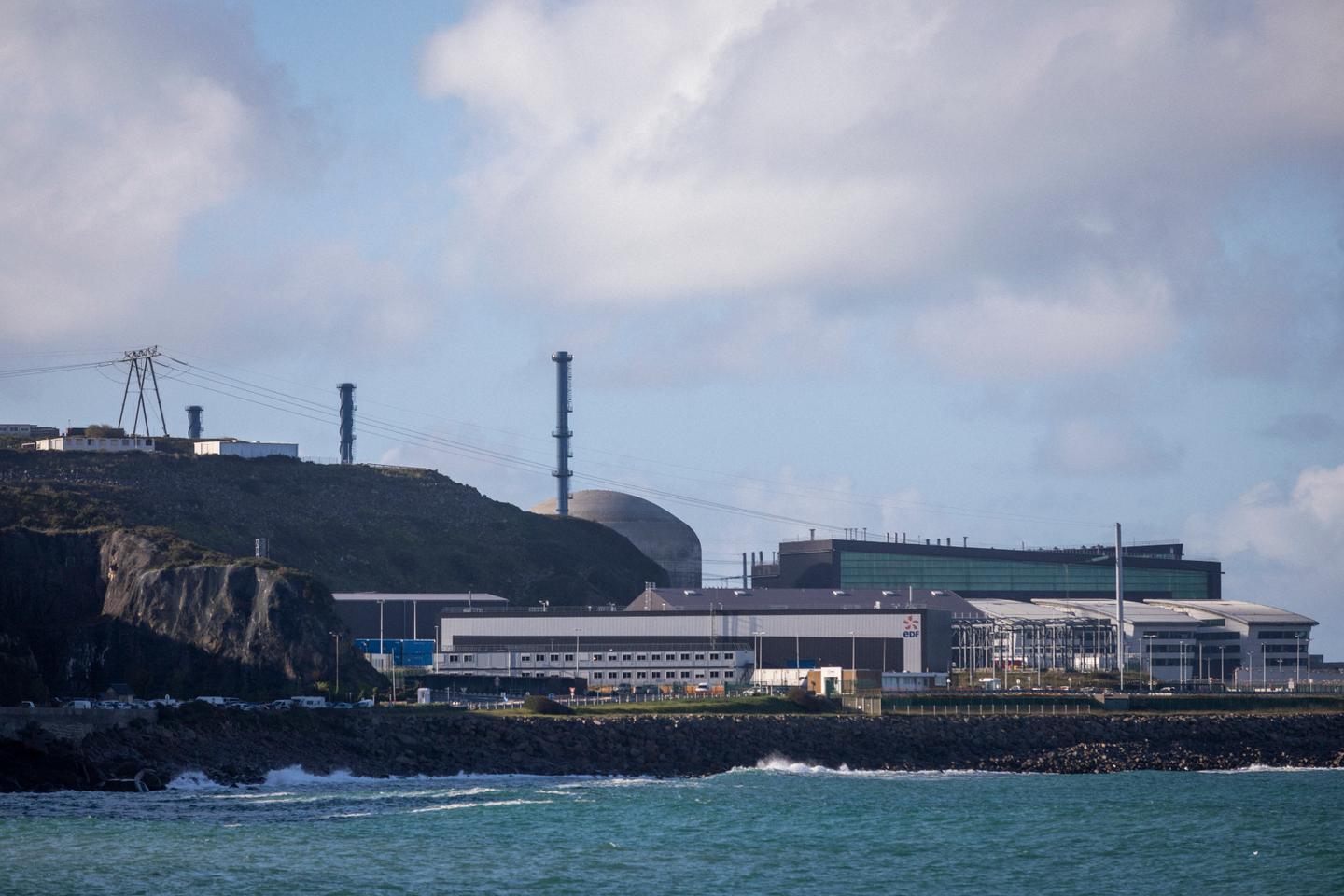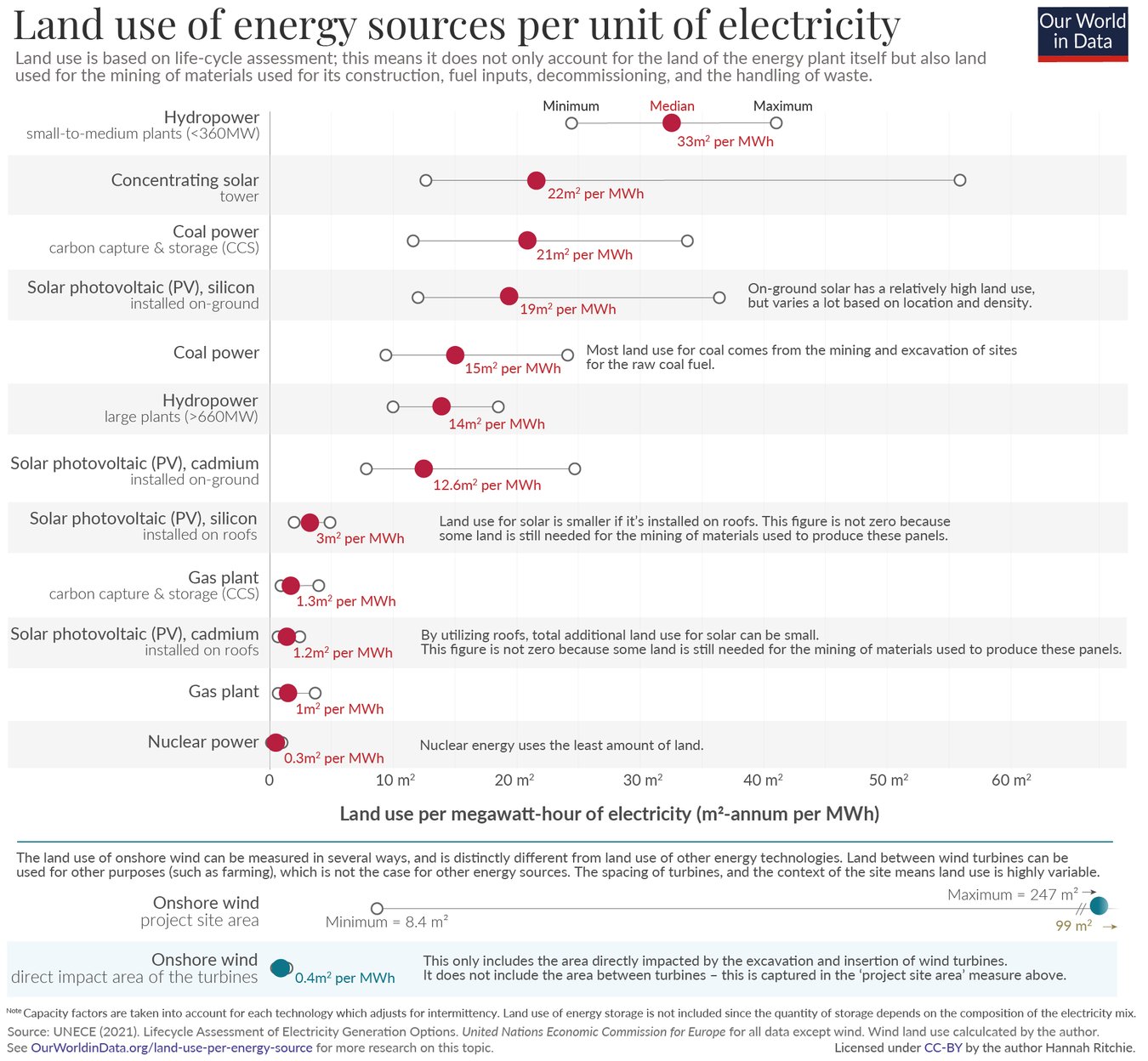Summary
France’s Flamanville 3 nuclear reactor, its most powerful at 1,600 MW, was connected to the grid on December 21 after 17 years of construction plagued by delays and budget overruns.
The European Pressurized Reactor (EPR), designed to boost nuclear energy post-Chernobyl, is 12 years behind schedule and cost €13.2 billion, quadruple initial estimates.
President Macron hailed the launch as a key step for low-carbon energy and energy security.
Nuclear power, which supplies 60% of France’s electricity, is central to Macron’s plan for a “nuclear renaissance.”



Even if wind and solar make huge progress, they will likely never be as efficient regarding raw materials efficiency and land use. Land use is the main contributor to biodiversity loss.
I don’t think peremptory opinions about technologies are going to help. We should use what ever technology is the most reasonable and sustainable for each specific location.
Total land used for all power to be supplied by solar would be a hilariously tiny percentage of land, so this just reads like a solar version of “its killing birds” to me.
Agrivoltaics also side steps this non issue, as interlacing solar panels into farm land increases yields for many crops while making efficent use of space that’s already spoiled any biodiversity. Can you do that with a nuclear reactor?
Yeah in a perfect world based on some rough data you could supply the entire planet’s energy requirements with a solar plant about 300,000 square kilometers, or basically the size of Arizona, which translates to about 0.2% of the total landmass on earth. That being said, I’m curious what a solar plant the cost of this nuclear plant would look like, and where they’d put it. I think centralized vs distributed land rights and compensation is really tougher than the tech at this point.
Nevada just built a hybrid 1400MW solar/battery plant for 2 billion dollars in 2 years.
That 1400MW is solar panel + battery output, so it doesnt match nuclear’s steady state, but ive done the math on these projects before. We should be able to can build a 3000MW solar generating plant with 1200MW battery supply for 16hrs at roughly a cost of 17 Billion dollars, or 1 Vogtle nuclear plant. My time estimate was 6 years. This would output 2x the power of the Vogtle plant during the day, and output just as much as it over the night.
The above makes solar/battery not only way more productive than nuclear, but way safer, and way faster to built. All of that is just with demonstrated, everyday tech available today. It ignores all the huge advances being made in various batteries and panels. In the decade+ that it would take to open just one more reactor, we will likely be able to 2x-3x the power and speed to build at a lower cost with just solar/battery.
Nuclear was the right answer for the last 50 years. That’s no longer the case.
wtf? Decentralized production is one of solar’s greatest advantages.
Nuclear could take over existing coal plants which would allow use of otherwise unusable land that’s been polluted by coal. It would require regulatory changes though, as the coal plant is already irradiated beyond allowed levels for nuclear.
Something to note about this chart is that ground-mount silicon solar PV isn’t considered for sharing land use with activities such as farming in comparison to how onshore wind is (i.e. agrivoltaics).
NREL in the US estimates that there are currently ~10.1 GW of agrivoltaics projects spread across ~62,400 acres (or ~7 m^2 / MW).
Even this being said, I think brownfield or existing structures for new PV is the way of the future for solar PV. There is so much real estate that could be used and has the potential to offset grid demand growth while providing greater reliability for consumers. You’ll need the big players to help with industrial loads, but even then, the growth of Virtual Power Plants (VPPs) has the potential to balance loads at the same scale as the big players for the prosumer market.
Edit: I’ll also make mention of floatovoltaics, or the installation of solar PV on bodies of water, either natural or artificial. This is a burgeoning side of the industry, but this is another area that could present net zero or even negative land use per unit of energy.
Don’t forget solar fences
Something to note about your link to solar fences is that one of the cons mentioned is that panels can’t produce power for half of the day because they’ll be facing away from the sun.
Bifacial panels exist and can collect energy from both faces of the module. We in the utility-scale space use these all the time. You’d want these over monofacial panels for fence applications
Yes. Bifacial seems like the obvious choice. And the fence should be NS orientation not EW.
If you’re trying to maximize energy collection then yes you’ll want to face the fence rows NS.
But there are also some benefits for making use of vertical bifacial panels oriented EW. You get a bimodal energy plot: one in the morning and one in the evening when the sun’s direct rays shine near horizontal (something NS panels can’t collect).
I’d actually be interested in reading the literature on mixing these types of panel orientations to see what the resulting production yields would look like, and if stakeholders like utilities would find any benefit in them to help better manage grid demand in those peripheral times of the day.
This is a poor argument. You just did what you explicitly should not do with Life Cycle Assessment (LCA) results.
The ISO 14044 specifically requires life cycle assessment to include all relevant impact categories. In particular in comparative analysis it is crucial to not single out any one category, but look at the impact on the endpoints, e.g. ecosystems or human health.
https://www.h2.de/fileadmin/user_upload/Einrichtungen/Hochschulbibliothek/Downloaddateien/DIN_EN_ISO_14044.pdf
See page 37 onwards.
Here is the full LCA study, that you drew only one category from
https://unece.org/sites/default/files/2022-04/LCA_3_FINAL March 2022.pdf
Look at the Endpoint indicators, like “Lifecycle impact on ecosystems, per MWh, in pointes”, “Life cycle impacts on ecosystems, no climate change,per MWh, in pointes”, “Life cycle impacts on human health,per MWh, in pointes” etc.
Nuclear power does fare well in these categories, but often only marginally different to Wind Power and Solar Power. It certainly does not offset the cost difference, when you also have to include the opportunity costs of running coal or gas plants longer.
This is a poor argument. You just did what you explicitly should not do when engaging in a discussion: building a straw man argument and cherry picking a part of an answer.
I highlighted two rarely mentioned and non-intuitive points about nuclear vs renewables, I bet a few readers learned about it. But, I didn’t say renewables shouldn’t be used. My conclusion says the opposite, don’t have blocked opinions about technologies, use whatever is most adapted to the location, if it’s renewable, that’s great.
There is no particular reason solar “needs” to use any new land at all, given that we can just put it on the roofs we already have.
And the fact that we do dedicate land to it instead of only doing rooftop just goes to show that land use isn’t anywhere near as important a problem as you insinuate.
Your comment is pure FUD.
You are very quick to deduct things. The reason land is dedicated to it is that it is not easy to organize with building owners to get it on the roof, compared to buying land building what you want on it, and equipping roofs is obviously more technical than building on the ground. We can’t just think it terms on what could be possible but what the reality is.
Countries who try to stop land artificialization to reduce impact on biodiversity struggle to, because of all the economical pressure where renewables may contribute, it’s not an easy subject.
Please try not to look for negative intentions, I am here to participate in the debate and learn with others.
Could you compare it to land used for livestock or car parks or low density housing?
If we went 100% solar is that even noticeable compared to mentioned above.
You just making excuses.
Could you not compare unrelated stuff? What you just did is called “whataboutism”.
“Land use is the main contributor to biodiversity loss”
Is that not a quote from what is being talked about.
How much of land use that is contributing to biodiversity loss is solar panels and wind? How much is energy in total?
It’s fuck all. So yea that is relevant.
I am not making any excuse, I’m providing additional points to consider.
Pointless points. It’s a rounding error in the grand scheme of things. You’re just a fossil fuel shill.
Why do you have to reduce a discussion to chilling? What a sad attitude.
I guess you’re not in a listening mood, but in case you are, let me state my opinion: I am in favor of all solutions that will help reduce the ecological crisis, which means reducing dependency of fossil fuels, raw materials extraction, and land usage among other things. I think both nuclear and renewables are good solutions for that, but they both have issues, so let’s use what is most appropriate for every use case.